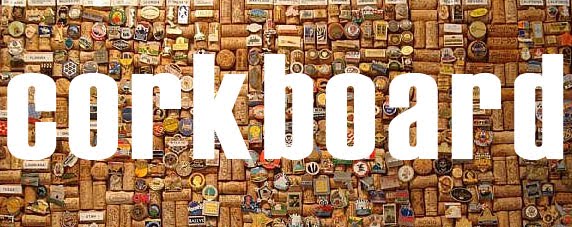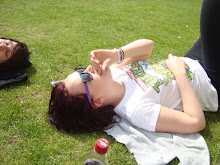Paul managed to wangle us free tickets to London Art Fair 2010, so we made a command decision to day trip it - despite having no real interest in fine art. I'm not going to lie, when I said I'd go I did not have the visual language brief in mind, I just like visiting random places. But when we were there it was sort of 'hannnnng on a second.. THIS IS CURATION' and, boom, there it was, the deep learning began.
Again, I won't lie - I was more than moderately hungover so although I did try my best to link together what I was seeing with my projects, my main priority throughout most of the day was staying alive, not feinting and trying not to let too many people smell me. I really did try though, honest.
First observation - the Business Design Centre in Islington is HUGE. Literally once you were in there trying to locate the exit amongst all of the temporary walls was like trying to unearth Narnia in the bedroom section of an MFI warehouse. The space itself was insanely big, and then it had an extra 3 floors on top of that spreading across what must have been best part of the building.
There was definitely some pretty cool stuff floating around but a lot of it was really fine art-y and I'm just not into that - I did take pictures of things that I saw and went 'oooh that's very viscom' - I'll upload them shortly.
It wasn't until after we'd left that it sort of dawned on me just how relevant that experience actually was.. Despite being on an immensely bigger scale, the art fair bore many similarities to our 129 exhibition. The fair encompassed well over 100 individual galleries coming together to showcase the art they had to offer. The exhibition space had to be divided so that each gallery was given an equal amount of wall space but in a way that made the divisions between each gallery clear (not directly linked to the salon style of 129 but certainly to the graduate and end of year exhibitions). After taking part in the curatorial side of our own exhibition I'm struggling to fathom just how many decisions had to be made for something this mammoth. I did notice though, that the many of the curatorial aspects within each gallery space had been left up to the gallery themselves - it looked as though they were free to do what they chose with the space they were given but there were common threads such as the white walls running throughout.
It completely crossed my mind to look at the fixtures, I'd be interested to know if they were standard throughout. However I don't think they would have been.. It's a temporary exhibition with the aim of selling work, so in theory that would mean that it should be easily removed from the wall if someone chooses to buy it, and also, most galleries seemed to have brought more artwork than they had wall space and were rotating the pieces on display during the course of the day so I'm taking a stab in the dark and saying that wherever light enough canvases and smaller frames were hung on nail and string? It was obvious that some of the larger pieces were a lot more definitive in their presence and had to be secured thoroughly, but logically I would have thought that something like mirror brackets would have been impractical for the purpose of the fair.
I also forgot to take a gander at the labeling - however I did read a lot of the labels and my current thought process is that I would have noticed if there was major in-continuity which suggests to me that they were all pretty standard. To be fair there's not that much controversy you can cause with label design as far as I'm aware.
Oh, and Paul is sure he saw Bill Bailey. I was sleeping with my eyes open so I missed him.
So that was looking at constructing a temporary exhibition in something that is not fundamentally a gallery space, a.k.a. Viscom. We then decided (after a few hours in Camden) to visit the Tate (mainly for the bookshop but we did then decide it would be a wasted journey if we didn't look around), a permanent exhibition space designed specifically to exhibit artwork. I think a comparison is in order.
Again, I didn't realise the relevance of all of this at the time so I'm analysing entirely from memory.
The main apparent difference is that the finishing in the Tate was impeccable - as you would obviously expect. The exhibition style (in the free galleries, I can't speak for the one that I apparently had to pay to criticise) was somewhere in between that of salon and individually hung. They were mostly hung at random heights - eye level or above - in what appeared to be (but evidently wasn't) a haphazard way, but the spacing between each piece was quite vast. Because the ceilings are so high as well I can't really work out what I made of it to be perfectly honest.. I don't think I liked it much.
I can't remember what colour the walls were but I do know they weren't white - I'm fairly sure there was some sludgy greeny/grey involved? I could be mistaken, I should really have paid attention to these things. Either way it worked well, the decision to plaster everything in white would have totally sterilised the entire space due to the insane amount never ending walls, it would have looked very hospital/mental asylum-esque. This way, it felt a little bit more homely.. as homely as the Tate can be - it was warmer and more welcoming.
I don't really know what else to say about the Tate. I'm not a massive arty-farty person; if something is obviously good I'll appreciate it, but if someone has just smeared a load of red paint into a half chewed piece of paper then chances are I'm not going to give a crap, and unfortunately the majority of the content was in fact the latter. I'm glad I went, I hadn't been before then but will I be traveling an 8 hour round trip on a coach to see it again? No, jog on.
Death bed aside, I had a good day and, if anything, my suffering provided Paul with mild entertainment, everyone's a winner.


No comments:
Post a Comment